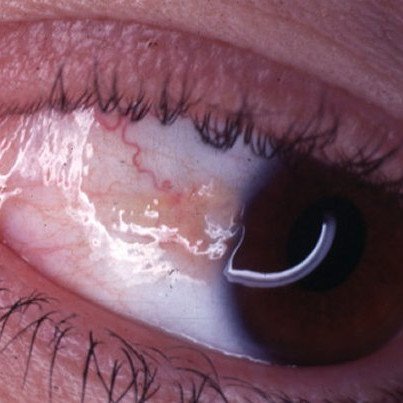What is Pinguecula?
A pinguecula is a yellowish deposit on the conjunctiva adjacent to the cornea. It is a non-cancerous growth that results from calcium, fat or protein deposits. A pinguecula is almost similar to a pterygium, the latter, however, is wedged shaped. Although non-cancerous, it may grow larger over the years. A pinguecula would usually develop on the eye side closest to the nose. It is derived from the Latin word, “pinguis,” which means fat.
Causes of Pinguecula
- Although the cause is still unknown, the most prevalent contributing factor for both pinguecula and pterygium is an exposure to ultraviolet radiation.
- Prolonged eye irritation may also advance its development.
- Dry eyes and environmental factors like wind and dust could also be a possible culprit for pinguecula to develop.
- Exposure to harmful chemicals and mechanical damage to the conjunctiva may also precipitate the formation of a pinguecula.
- Persons living in tropical climates also appear to have a greater risk of developing this eye condition.
- In addition, persons who are over 40 have a higher risk but a pinguecula can also be common among persons aged 20 to 30 who spend significant amount of time under the sun.
Symptoms of Pinguecula
A person who has pinguecula usually does not experience any symptom other than the development of a yellowish nodule in the eye. If, however, it becomes irritated, a person may experience a feeling of having something in the eye.
Redness and swelling of the eye may occur if irritation persists and eventually worsens. If this happens, pingueculitis may occur. A pinguecula may also increase in size over the years.
Pinguecula Picture

Diagnosis
- An eye examination done by an ophthalmologist would confirm the diagnosis for pinguecula
- A slit-lamp may be used to allow the physician to examine the cornea, iris, lens, and the space between the cornea and the iris. Abnormalities would then be easily noted as the eye would be viewed at various small sections.
Treatments for Pinguecula
Once a pinguecula is suspected, it would be best to be referred to a doctor. Although enlargement of a pinguecula is possible, it would usually not require any form of treatment during the benign stages. Artificial tears or lubricating drops may be used to ease discomfort, redness or eye irritation. Stronger prescription drops may also be used to halt further enlargement of the nodule. Anti-inflammatory drugs may also be used to address discomfort and inflammation.
Can a pinguecula be removed?
Once a pinguecula is fully developed, it may no longer respond to topical treatments.
- An established pinguecula may be removed once the nodule enlarges and threatens the eye sight as well as cause possible vision loss.
- Extreme discomfort may also prompt the patient to have the pinguecula removed. This can be done as an outpatient surgery by an eye specialist.
- A pinguecula may also be removed for aesthetic and cosmetic purposes especially once the yellowish nodule becomes too obvious.
- In addition, those who are using contact lenses may find it difficult to wear their lenses thereby requiring them to undergo surgery.
The surgical procedure is usually painless and could be done in less than an hour. Topical anesthetics are used to minimize sensation during the surgery. After the procedure, eye drops instillation may be required to help ease swelling and prevent complications. Eye patch may also be necessary. Work activities may be resumed after a day or two as long as it would not causes excess strains on the eye.
Preventive Measures
However, undergoing surgery does not mean that the reoccurrence of pinguecula in the future would no longer be possible. It is still, therefore, important to avoid excessive exposure to UV light. Sunglasses with UV protection and safety occupational glasses are usually appropriate to use when frequent exposure to ultraviolet light is unavoidable.
In addition, this eyewear could also provide protection against environmental elements like dust and wind. Moreover, the use of artificial tears could also be beneficial once eye dryness is felt, especially during humid and dry conditions.
Pinguecula is an eye condition that may not need immediate attention of an eye specialist. But it would still be best to have a physician check it once noted or if discomfort is already felt. Treatment should best be done under a physician’s supervision more than self-medication and treatments.
References:
http://www.nlm.nih.gov/medlineplus/ency/article/001025.htm
http://www.umm.edu/ency/article/001025trt.htm
